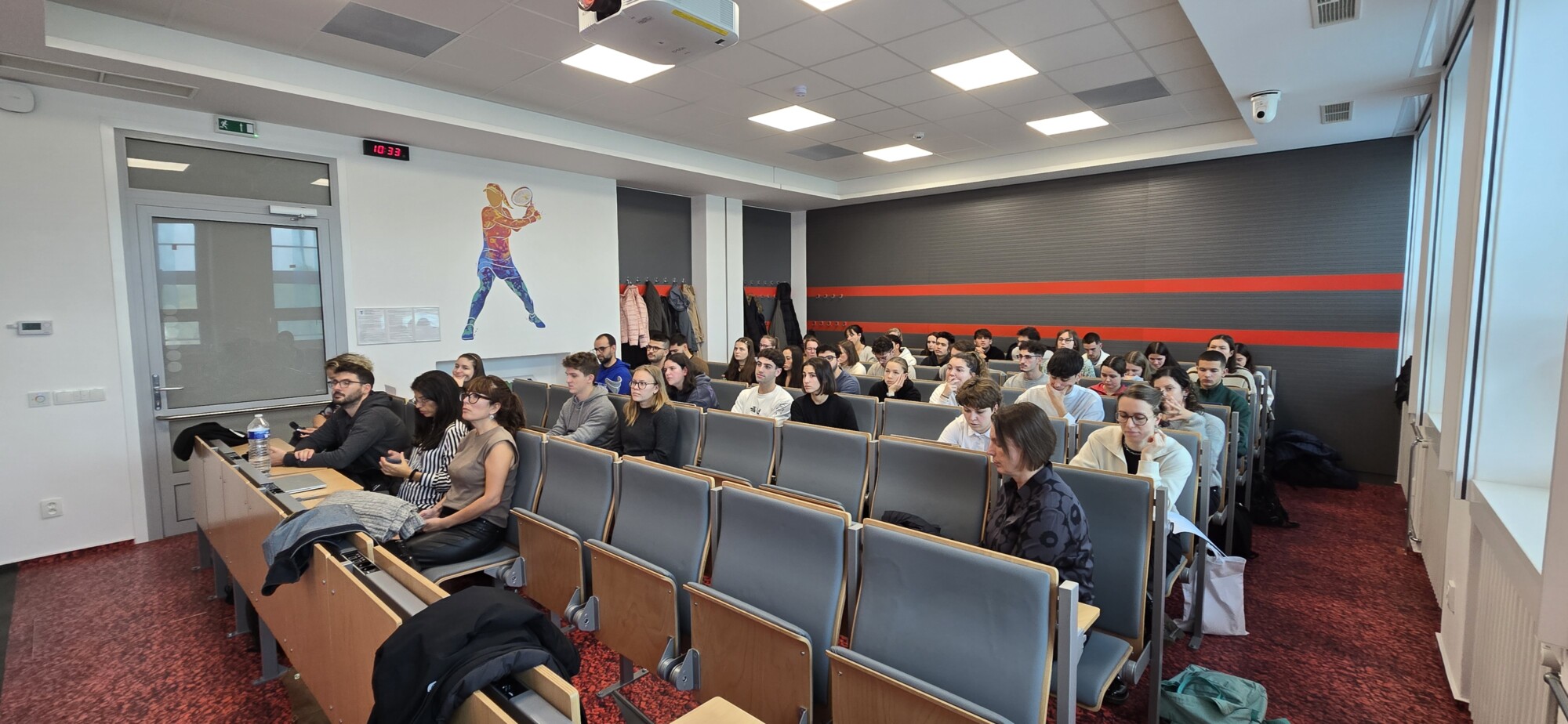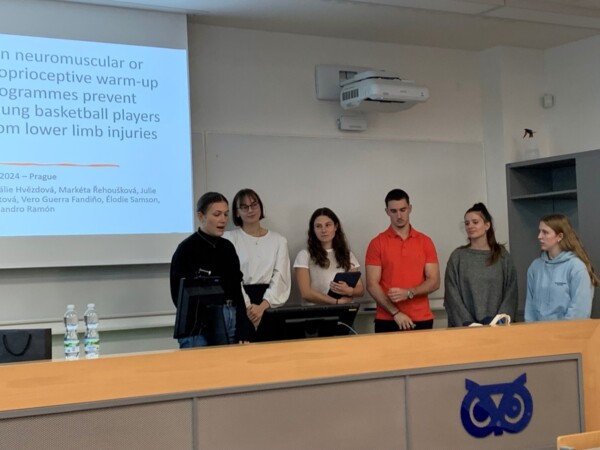
Savonia Article Pro: Can neuromuscular or proprioceptive warm-up programmes prevent young basketball players from lower limb injuries?
Savonia Article Pro is a collection of multidisciplinary Savonia expertise on various topics.
This work is licensed under CC BY-SA 4.0
INTRODUCTION
Evidence-Based Physical Therapy (EBP) uses the best research evidence with clinical expertise and user’s preferences to produce the most appropriate and effective care. At week 43 in 2024, we had Blended Intensive program (BIP) in Czech Republic, Charles University about EBP. This BIP program opened with welcome words of the president of The European Network of Physiotherapy in Higher Education (ENPHE) and followed with the basis of EBP and teachers who highlighted the main challenges at different Physical Therapy fields.
More than 43 physiotherapy students and 8 teachers from five universities (Savonia University of Applied Sciences, Finland, Universidade da Coruña, Spain, Charles University Prague, Universidad Europea de Madrid, Spain and CEERRF, France), actively participated this week and shared experiential group dynamics and social activities (Picture 1). Students worked together and wrote articles devoted to the following themes: Evidence Based in sport, prevention, injuries, neurological diseases, respiratory diseases, cardiovascular diseases, children and older adults. In this learning task, students practiced conducting a mini review and using PEDro scale to assess the quality of a studies. In the following you can consult the work presented by the students on sport and prevention topic.

BACKGROUND
Neuromuscular training (NMT) programs include exercises that can be categorized into aerobic, balance, strength, and agility components and typically last 10–15 minutes. These programs were initially developed to reduce the risk of non-contact lower extremity injuries and have been evaluated across various sports, age groups, and levels of play. Research has shown that they are associated with lower extremity and overall injury rates compared to standard warm-up practices, reducing injury rates by up to 60% (Lutz et al. 2024). Our review will compare five studies to continue observing the benefits of neuromuscular warm-up programs in reducing injury frequency among young basketball players through various protocols, including specific characteristics of such programs.
The objective of this review is to determine whether performing a neuromuscular or proprioceptive warm-up program helps reduce the frequency of lower limb injuries in basketball players aged 11 to 25.
METHODOLOGY
A systematic review was conducted using health-related databases, namely PubMed and PEDro, to investigate the effect of a neuromuscular or proprioceptive warm-up program on young basketball players.
Regarding the search strategy, the review primarily focused on terms related to basketball and injuries in connection with neuromuscular warm-up programs. Specific keywords were used to identify the most relevant articles for inclusion, such as “sports,” “injury,” “training,” “warm-up,” “lower limb injuries,” and “basketball players.” The only filter applied was “Randomized Controlled Trials.”
In terms of selection criteria for including studies in the review, only randomized controlled trials involving an intervention based on a neuromuscular warm-up program for young basketball players aged 11 to 25, who were not elite players, were considered. The exclusion criteria for studies were as follows: (1) the intervention did not align with the definition of neuromuscular training. (2) the study was published before 2004, (3) participants were over 25 years old, (4) participants were not basketball players (5) injury prevention was not measured, and (6) the study was not a Randomized Controlled Trial. The reliability of all articles included in the review was assessed using the PEDro scal. (Picture 2).
RESULTS
After entering the keywords, 104 articles were retrieved from the databases. Following the removal of duplicates, article review, and application of the established criteria, only six studies were included in the analysis. All selected studies were randomized controlled trials. (Emery et al. 2022; Foss et al. 2018; LaBella et al. 2011; Lim et al. 2009; Stojanović et al. 2022; Eils et al. 2010)

CONCLUSION
After analyzing all of the studies, we observe that implementing a neuromuscular warm-up for young basketball players effectively helps prevent lower limb injuries. Five studies showed positive results, while one study showed neither positive nor negative outcomes. It appears that the effectiveness of neuromuscular warm-ups may be reduced if participants practice alone at home rather than under supervision. This conclusion is suggested by the study that did not demonstrate significant evidence of effectiveness, though this has not been definitively proven. Future research could focus on this aspect or investigate how the duration of the neuromuscular warm-up impacts its effectiveness.
Authors:
Natálie Hvězdová, physiotherapy student, Charles University, Czech Republic
Markéta Řehoušková, physiotherapy student, Charles University, Czech Republic
Julie Baštová, physiotherapy student, Charles University, Czech Republic
Vero Guerra Fandiño, physiotherapy student, University of A Coruña, Spain
Élodie Samson, physiotherapy student, CEERRF, France
Alejandro Ramón, physiotherapy student, Universidad Europea de Madrid, Spain
Dagmar Pavlu, Physiotherapist, Assoc. Prof. Charles University, Czech Republic
Marja Äijö, PT, PhD Principal Lecturer of gerontology and rehabilitation. Savonia, University of Applied Sciences, Kuopio, Finland
Veronica Robles García, PhD. PT. OT. Lecturers at University of A Coruña, A Coruña, Spain
Lorena Canosa Carro, PT, MSc, PhD. Lecturer at Universidad Europea de Madrid, Spain
Adrien Pallot, PT, MSc, Lecturer at CEERRF, France
Ivana Vláčilová, Physiotherapist, PhD. Charles University, Czech Republic
Beatriz Martínez Toledo, PT. Lecturer at University of A Coruña, A Coruña, Spain.
Montserrat Fernández Pereira, PT, Lecturer at University of A Coruña, A Coruña, A Coruña, Spain.
References:
Lutz, D., Van Den Berg, C., Räisänen, A. M., Shill, I. J., Kim, J., Vaandering, K., Hayden, A., Pasanen, K., Schneider, K. J., Emery, C. A., & Owoeye, O. B. A. (2024). Best practices for the dissemination and implementation of neuromuscular training injury prevention warm-ups in youth team sport: a systematic review. British Journal Of Sports Medicine, bjsports-106906. https://doi.org/10.1136/bjsports-2023-106906
Emery, C. A., Owoeye, O. B., Räisänen, A. M., Befus, K., Hubkarao, T., Palacios-Derflingher, L., & Pasanen, K. (2022). The “SHRed Injuries Basketball” Neuromuscular Training Warm-up Program Reduces Ankle and Knee Injury Rates by 36% in Youth Basketball. Journal Of Orthopaedic And Sports Physical Therapy, 52(1), 40-48. https://doi.org/10.2519/jospt.2022.10959
Foss, K. D. B., Thomas, S., Khoury, J. C., Myer, G. D., & Hewett, T. E. (2018). A School-Based Neuromuscular Training Program and Sport-Related Injury Incidence: A Prospective Randomized Controlled Clinical Trial. Journal Of Athletic Training, 53(1), 20-28. https://doi.org/10.4085/1062-6050-173-16
LaBella, C. R., Huxford, M. R., Grissom, J., Kim, K., Peng, J., & Christoffel, K. K. (2011). Effect of Neuromuscular Warm-up on Injuries in Female Soccer and Basketball Athletes in Urban Public High Schools. Archives Of Pediatrics And Adolescent Medicine, 165(11), 1033. https://doi.org/10.1001/archpediatrics.2011.168
Lim, B., Lee, Y. S., Kim, J. G., An, K. O., Yoo, J., & Kwon, Y. H. (2009). Effects of Sports Injury Prevention Training on the Biomechanical Risk Factors of Anterior Cruciate Ligament Injury in High School Female Basketball Players. The American Journal Of Sports Medicine, 37(9), 1728-1734. https://doi.org/10.1177/0363546509334220
Eils, E., Schröter, R., Schröder, M., Gerss, J., & Rosenbaum, D. (2010). Multistation Proprioceptive Exercise Program Prevents Ankle Injuries in Basketball. Medicine & Science In Sports & Exercise, 42(11), 2098-2105. https://doi.org/10.1249/mss.0b013e3181e03667
Stojanović, E., Scanlan, A. T., Radovanović, D., Jakovljević, V., & Faude, O. (2022). A multicomponent neuromuscular warm-up program reduces lower-extremity injuries in trained basketball players: a cluster randomized controlled trial. The Physician And Sportsmedicine, 51(5), 463-471. https://doi.org/10.1080/00913847.2022.2133978